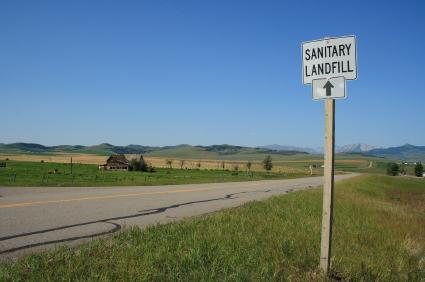Solid Waste
Waste Reduction & Global Climate Change

Solid waste reduction and recycling help address global climate change. The manufacture, distribution and use of products – as well as management of the resulting waste – all result in greenhouse gas emissions. Waste prevention and recycling reduce greenhouse gases associated with these activities by reducing methane emissions, saving energy, and increasing forest carbon sequestration.
The California waste stream is primarily composed of organic (food) waste, paper products, and construction and demolition debris. Harder to decompose items such as plastic, glass, metal, electronic and hazardous wastes are also present in the waste stream in significant amounts. Traditional solid waste management has relied heavily on large landfills, and to a lesser degree incineration. However Federal, state and local laws and regulations are forcing a move towards waste prevention and minimization, including greater reliance on recycling and diversion.
California Integrated Waste Management Act
The California Integrated Waste Management Act (AB 939) requires that local governments prepare waste diversion plans. Now, recent legislation, AB 341, requires that 75% of the waste stream be recycled by 2020 and planning is underway to achieve that goal. The current State Agency dealing with waste issues is the Department of Resources Recycling and Recovery (CalRecycle).
Waste Prevention & Recycling
SCAG is responsible for looking at both short and long term solutions to effectively address the regional waste problem. In the short term, the region will still need to rely heavily on landfills and, when local facilities have filled to capacity, exporting the waste to other areas, leading to higher trash rates and added traffic congestion and air pollution. In the long term, SCAG will assist the region in changing the way residents and businesses think about trash and move towards a system of waste prevention and minimization. The move towards this system will take time and require a variety of waste management strategies, including extensive use of recycling. The SCAG region will need to achieve maximum diversion from landfills through emerging technologies, policies and best management practices.
SCAG SOLID AND HAZARDOUS WASTE MANAGEMENT
SCAG works with local jurisdictions to help develop local and regional solid waste policies that help support state solid waste goals while supporting SCAG’s plans, such as the 2016-2040 Regional Transportation Plan / Sustainable Communities Strategy currently under development. In addition, SCAG monitors the development of hazardous waste management planning, pursuant to the California Health and Safety Code.
METHANE REDUCTION
The California Air Resources Board (CARB) approved a new regulation that reduces emissions of methane, a greenhouse gas, from municipal solid waste (MSW) landfills. The regulation, which became effective June 17, 2010, is a discrete early action greenhouse gas emission reduction measure, as described in the California Global Warming Solutions Act (“AB 32”). The regulation primarily requires owners and operators of certain uncontrolled MSW landfills to install gas collection and control systems, and requires existing and newly installed gas and control systems to operate in an optimal manner. The regulation allows local air districts to voluntarily enter into a memorandum of understanding with CARB to implement and enforce the regulation and to assess fees to cover costs.
INCINERATOR EMISSIONS REDUCTION
The use of incinerators to burn solid waste is an old technology. Historically, incinerators have created a number of undesirable by-products (solid, liquid, and gas). Conversion technologies (CTs) refer to a set of processes designed to reduce the by-products of incineration, and to create useful products such as industrial chemicals or gas, liquid, and solid fuels. The attraction of CTs is their ability to convert landfill waste into products that can take the place of fossil fuels mined from natural resources. One such process is Thermal (thermochemical) conversion, and is characterized by the use of high temperatures to achieve high conversion rates of dry, organic material. This process can include these techniques: gasification, pyrolysis, plasma arc, and catalytic cracking.
ENERGY CONSUMPTION EMISSION REDUCTIONS
One strategy to reduce GHG emissions is from reducing energy consumption. Recycling saves energy. Manufacturing goods from recycled materials usually requires less energy than producing goods from new materials. Waste prevention is even more effective at saving energy. When people reuse things or when products are made with less material, less energy is needed to extract, transport, and process raw materials and to manufacture products. In short, when energy demand decreases, fewer fossil fuels are burned and less CO2 is emitted into the atmosphere.
CARBON SEQUESTRATION
When CO2 is removed from the atmosphere by photosynthesis or other processes and stored in sinks (like forests, landfills or soil), it is sequestered. The principal carbon storage mechanisms under consideration are forests (related to paper and wood recycling), long-term storage of carbon in landfills, and the accumulation of carbon in soils resulting from compost application. Studies are under way to determine the value of these techniques to long-term greenhouse gas reduction efforts. However, the EPA currently includes estimates of carbon storage from landfills and forests in its national GHG inventory.